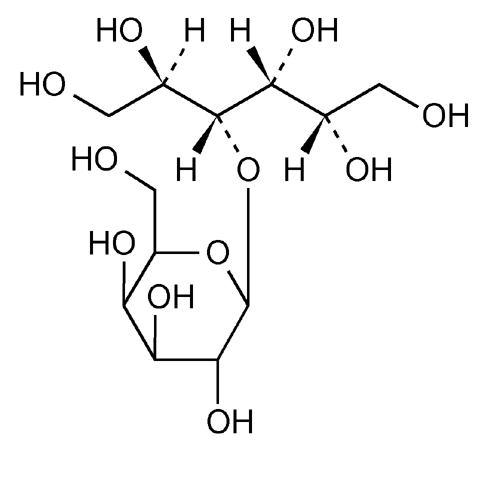Lactitol
4-O-
Monohydrate. 362.34
Dihydrate. 380.35
» Lactitol contains not less than 98.0 percent and not more than 101.0 percent of C12H24O11, calculated on the anhydrous basis.
Packaging and storage—
Preserve in well-closed containers.
Labeling—
Label it to indicate whether it is the monohydrate, the dihydrate, or the anhydrous form.
Identification, Infrared Absorption  197K
197K .
.
Water, Method I  921
921 —
between 4.5% and 5.5% (monohydrate); between 9.5% and 10.5% (dihydrate); and not more than 0.5% for the anhydrous form.
—
between 4.5% and 5.5% (monohydrate); between 9.5% and 10.5% (dihydrate); and not more than 0.5% for the anhydrous form.
Residue on ignition  281
281 :
not more than 0.5%.
:
not more than 0.5%.
Heavy metals  231
231 —
Dissolve 4 g of it in 25 mL of water: the limit is 5 µg per g.
—
Dissolve 4 g of it in 25 mL of water: the limit is 5 µg per g.
Reducing sugars—
Dissolve 500 mg of it in 2.0 mL of water in a 10-mL conical flask. Into a similar flask, pipet 2 mL of a dextrose solution containing 0.5 mg per mL. Concomitantly add 1 mL of alkaline cupric tartrate TS to each solution, heat to boiling, and cool: the lactitol solution shows no more turbidity than that produced in the dextrose solution, in which a reddish brown precipitate forms (0.2%, as dextrose).
Related compounds—
Standard solution—
Dissolve an accurately weighed quantity of USP Lactitol RS in water to obtain a solution having a known concentration of about 0.3 mg per mL.
Chromatographic system—
Proceed as directed in the Assay, except to chromatograph the Standard solution instead of the Standard preparation.
Test solution—
Use the Assay preparation, prepared as directed in the Assay.
Procedure—
Separately inject equal volumes (about 25 µL) of the Standard solution and the Test solution into the chromatograph, record the chromatograms, and measure the peak responses. The relative retention times are about 0.53 for lactose, 0.58 for glucose, 0.67 for galactose, 0.72 for lactulitol, 1.0 for lactitol, 1.55 for galactitol, and 1.68 for sorbitol. Calculate the percentages of galactitol, sorbitol, lactulitol, lactose, glucose, and galactose in the portion of Lactitol taken by the formula:
100(CV/W)(rU / rS)
in which C is the concentration, in mg per mL, of USP Lactitol RS in the Standard solution; V is the volume, in mL, of the Test solution; W is the weight, in mg, of Lactitol in the Test solution; rU is the peak response of the relevant related compound, if observed, obtained from the Test solution; and rS is the lactitol peak response obtained from the Standard solution. The total of the percentages of all related compounds is not more than 1.5%.
Assay—
Mobile phase—
Use water.
Standard preparation—
Dissolve an accurately weighed quantity of USP Lactitol RS in water to obtain a solution having a known concentration of about 10.0 mg per mL.
Assay preparation—
Transfer about 1000 mg of Lactitol, accurately weighed, to a 100-mL volumetric flask, dissolve in and dilute with water to volume, and mix.
Chromatographic system
(see Chromatography  621
621 )—The liquid chromatograph is equipped with a refractive index detector and a 7.8-mm × 30-cm column that contains packing L34. The column is maintained at 85
)—The liquid chromatograph is equipped with a refractive index detector and a 7.8-mm × 30-cm column that contains packing L34. The column is maintained at 85 , and the flow rate is about 0.7 mL per minute. Chromatograph the Standard preparation, and record the peak responses as directed for Procedure: the relative standard deviation for replicate injections is not more than 1.0% for lactitol.
, and the flow rate is about 0.7 mL per minute. Chromatograph the Standard preparation, and record the peak responses as directed for Procedure: the relative standard deviation for replicate injections is not more than 1.0% for lactitol.
Procedure—
Separately inject equal volumes (about 25 µL) of the Standard preparation and the Assay preparation into the chromatograph, record the chromatograms, and measure the peak responses. Calculate the quantity, in mg, of C12H24O11 in the portion of Lactitol taken by the formula:
100C(rU / rS)
in which C is the concentration, in mg per mL, of USP Lactitol RS in the Standard preparation, and rU and rS are the lactitol peak responses obtained from the Assay preparation and the Standard preparation, respectively.
Auxiliary Information—
Please check for your question in the FAQs before contacting USP.
Chromatographic Column—
| Topic/Question | Contact | Expert Committee |
| Monograph | Elena Gonikberg, Ph.D.
Senior Scientist 1-301-816-8251 |
(MDGRE05) Monograph Development-Gastrointestinal Renal and Endocrine |
| Reference Standards | Lili Wang, Technical Services Scientist 1-301-816-8129 RSTech@usp.org |
USP32–NF27 Page 1263
Pharmacopeial Forum: Volume No. 31(4) Page 1143
Chromatographic columns text is not derived from, and not part of, USP 32 or NF 27.
